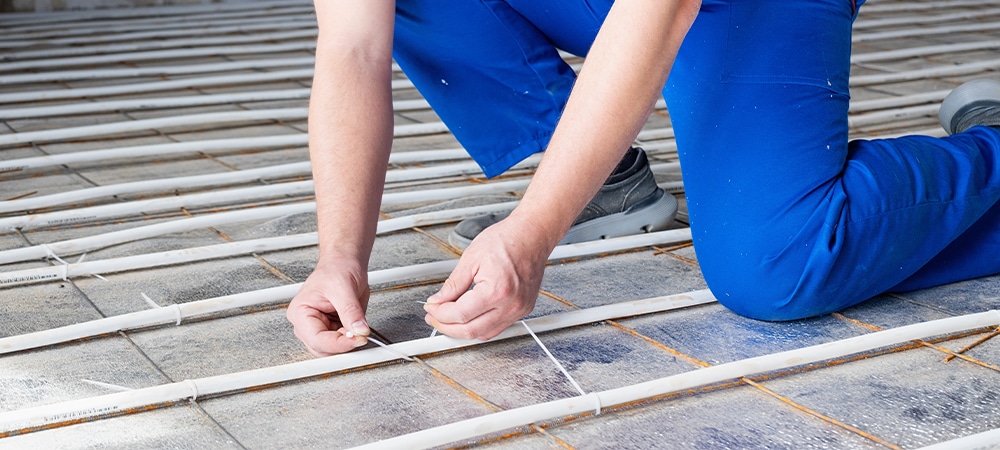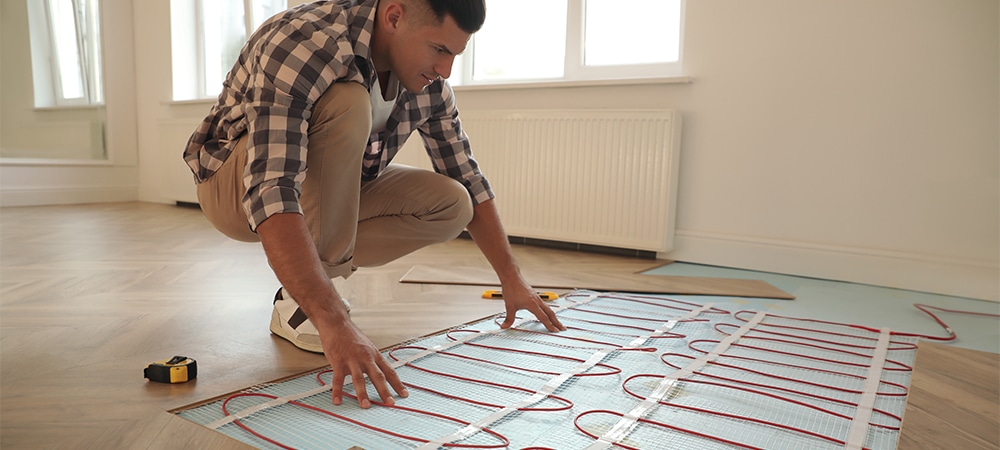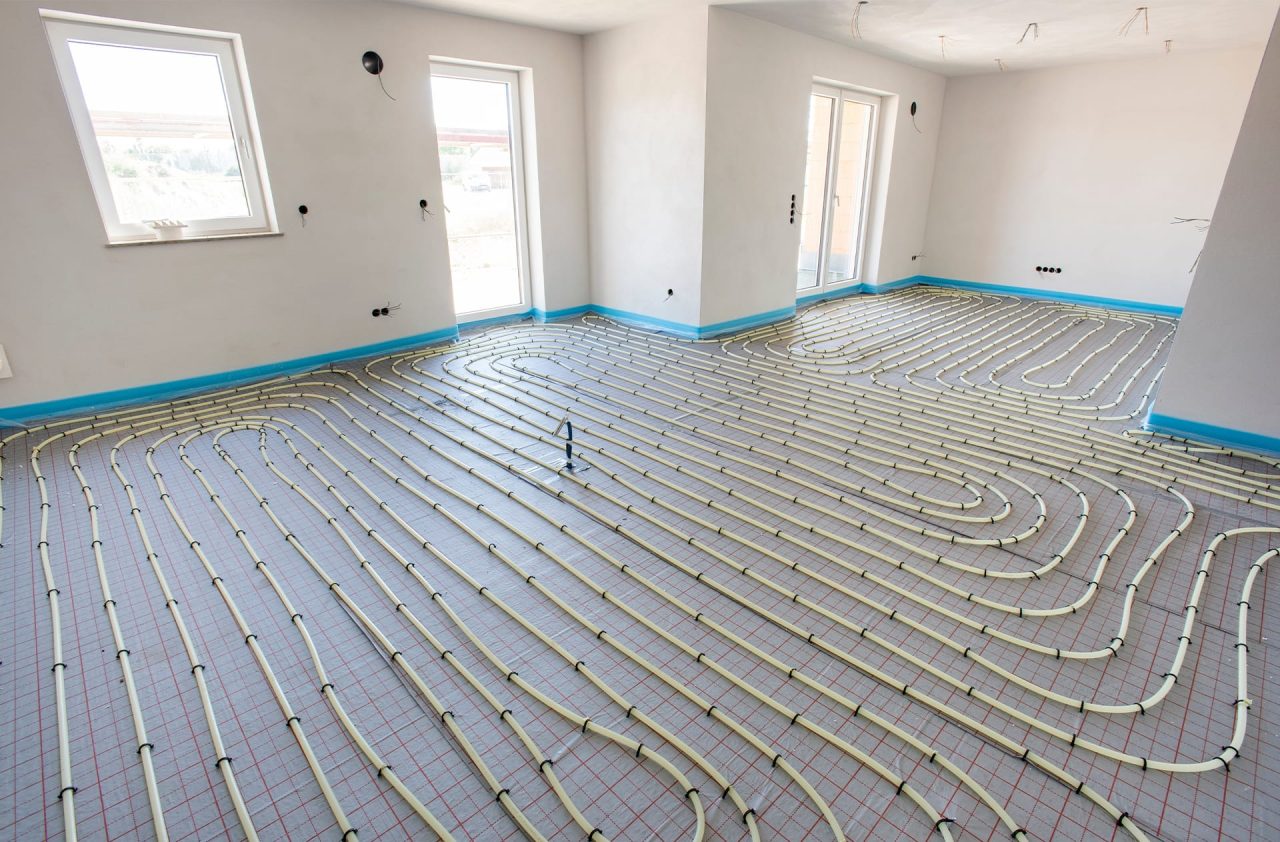Imagine stepping out of bed onto a warm, inviting floor on a chilly winter morning. That’s the luxurious comfort that underfloor heating, also known as radiant floor heating, can bring to your home.
This innovative heating system once considered a luxury, is rapidly gaining popularity among homeowners in Canada due to its numerous benefits, including enhanced comfort, energy efficiency, and a sleek, minimalist aesthetic.
Unlike traditional forced-air heating systems that rely on blowing hot air around a room, underfloor heating gently warms the floor, radiating heat upwards and creating a consistent and comfortable temperature throughout the entire space. This eliminates cold spots and drafts, providing a cozy and inviting atmosphere, especially during harsh Canadian winters.
This blog will help you choose the perfect flooring solution for your home, whether you’re considering hardwood, engineered hardwood, laminate, or vinyl.
Types of Underfloor Heating
Underfloor heating systems come in two main varieties, each with advantages and considerations: electric and hydronic. Understanding the distinctions between these systems is crucial in choosing the right one for your home and flooring type.
Electric Systems
Electric underfloor heating systems utilize heating cables or mats embedded within the floor structure. These cables or mats generate heat when an electric current passes through them, warming the floor and radiating that warmth into the room. Electric systems are generally more straightforward and less expensive, making them popular for smaller areas or retrofit projects. However, due to the cost of electricity, they can be more expensive to operate in the long run.
Hydronic Systems
Hydronic underfloor heating systems, on the other hand, rely on a network of hot water pipes installed beneath the floor. A boiler or heat pump heats the water, which then circulates through the pipes, transferring heat to the floor and the surrounding space.
Hydronic systems are known for their energy efficiency, especially in larger areas or when combined with renewable energy sources like solar or geothermal. However, they can be more complex and expensive to install, requiring additional plumbing and a dedicated heat source.
Installation Process
Both electric and hydronic underfloor heating systems require careful planning and installation to ensure optimal performance and longevity.
- Electric Systems: The installation typically involves laying down heating cables or mats on the subfloor, securing them in place, and then covering them with a layer of screed or thinset mortar before installing the final flooring.
- Hydronic Systems: Hydronic systems require the installation of a network of pipes beneath the floor connected to a boiler or heat pump. This process is more complex and often involves excavating the existing floor to accommodate the pipes. Once the pipes are in place, they are covered with screed or a specialized heat transfer plate before the final flooring is installed.
Regardless of your chosen system, working with a qualified professional is crucial to ensure proper installation and compliance with building codes and safety regulations.
Related Article: How to Find a Reliable Flooring Contractor: Your Guide to Outstanding Flooring Services in Toronto?

Benefits of Underfloor Heating
Underfloor heating offers many benefits beyond simply providing warmth. It transforms how you experience comfort in your home, enhances energy efficiency, and contributes to a healthier living environment.
Let’s explore some of the key advantages.
Comfort and Warmth
- Even and Consistent Heat Distribution: Unlike traditional radiators or forced-air systems that create hot and cold spots, underfloor heating provides a gentle, radiant warmth that spreads evenly throughout the room. This means you can enjoy a consistent temperature from floor to ceiling, eliminating uncomfortable drafts and cold feet.
- Luxurious Feeling: There’s nothing quite like stepping onto a warm floor on a cold winter day. Underfloor heating adds a touch of luxury to your home, creating a cozy and inviting atmosphere that you and your family will appreciate.
Energy Efficiency
- Lower Energy Bills: Underfloor heating systems can operate at lower temperatures than traditional heating systems, as the heat is radiated directly from the floor, warming objects and people in the room rather than just the air. This can lead to significant energy savings and lower heating bills over time.
- Reduced Carbon Footprint: By consuming less energy, underfloor heating can help reduce your carbon footprint and contribute to a more sustainable lifestyle. This is especially true when combined with renewable energy sources like solar or geothermal.
Space-saving and Aesthetically Pleasing
- No More Radiators: Underfloor heating eliminates the need for bulky radiators, freeing up valuable wall space and creating a cleaner, more streamlined aesthetic in your home. This can be particularly beneficial in smaller rooms or spaces where visual clutter is a concern.
Health Benefits
- Improved Air Quality: Underfloor heating doesn’t rely on circulating air, which can stir up dust and allergens, making it a potentially beneficial option for individuals with allergies or respiratory issues. Radiant heat also helps reduce humidity, which can discourage the growth of mould and mildew.
Related Article: What Should I Know About Installing Hardwood Floors in a Humid Climate?
Integrating Underfloor Heating with Your Flooring
When considering underfloor heating, it is important to choose a flooring type that is compatible with the system and can efficiently conduct heat. Let’s explore how underfloor heating integrates with various popular flooring options.
Hardwood Flooring
Hardwood flooring can be a beautiful and natural choice for underfloor heating, but selecting the right wood species and installation methods is crucial. Some wood species, like oak and maple, are known for their stability and ability to handle temperature fluctuations, making them suitable for underfloor heating. However, it’s essential to ensure proper wood acclimatization and use appropriate installation techniques, such as nailing or gluing, to prevent warping or gaps due to heat expansion.
Engineered Hardwood Flooring
Engineered hardwood, constructed with multiple layers of wood veneers, offers greater dimensional stability than solid hardwood, making it a good option for underfloor heating. Its layered structure minimizes the risk of warping or buckling due to changes in temperature and humidity. When choosing engineered hardwood for underfloor heating, ensure it has a suitable thickness and is specifically designed for radiant heat systems.
Laminate Flooring
Laminate flooring, a cost-effective alternative to hardwood, can also be used with underfloor heating, but select laminate with appropriate heat resistance. Look for laminate flooring that is specifically labelled as suitable for underfloor heating and has a low thermal resistance rating. This will ensure that the heat is efficiently transferred to the surface and prevent any damage to the flooring.
Vinyl Flooring
Vinyl flooring is generally compatible with underfloor heating due to its thin profile and good heat conductivity. However, it’s essential to check the manufacturer’s recommendations for the specific vinyl product you’re considering, as some types may have limitations on the maximum heat output they can tolerate.
At LV Hardwood Flooring, we have extensive experience integrating underfloor heating systems with various flooring types. Our team can guide you in selecting the right flooring and installation methods to ensure optimal performance and longevity. This lets you enjoy the comfort and efficiency of underfloor heating without compromising the beauty and durability of your floors.
Related Article: How to Care for Your Floors: Essential Tips and Techniques

Embrace the Warmth and Comfort of Underfloor Heating
Underfloor heating offers many benefits, transforming your living spaces into havens of comfort and efficiency. The even heat distribution, elimination of cold spots, and space-saving design make it an attractive option for any home. Its compatibility with various flooring types, including hardwood, engineered hardwood, laminate, and vinyl, allows you to enjoy the warmth and luxury of underfloor heating without compromising your aesthetic preferences.
If you’re considering a flooring upgrade or building a new home, we encourage you to explore the possibilities of underfloor heating.
Contact us today for a consultation or quote on your flooring and underfloor heating needs. Visit our website or call us at (416) 665-5645 to learn more about how we can transform your home with the warmth and comfort of underfloor heating.


